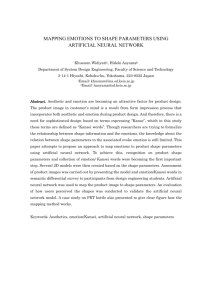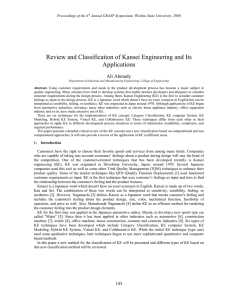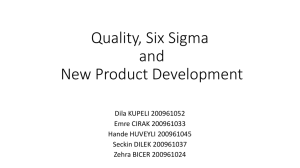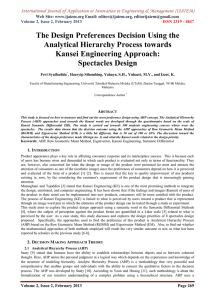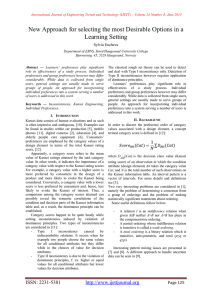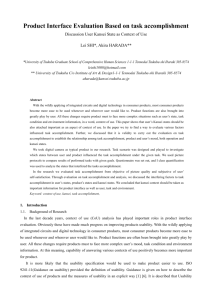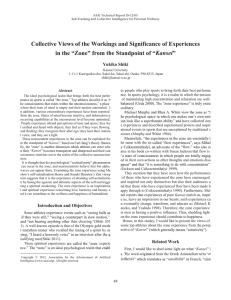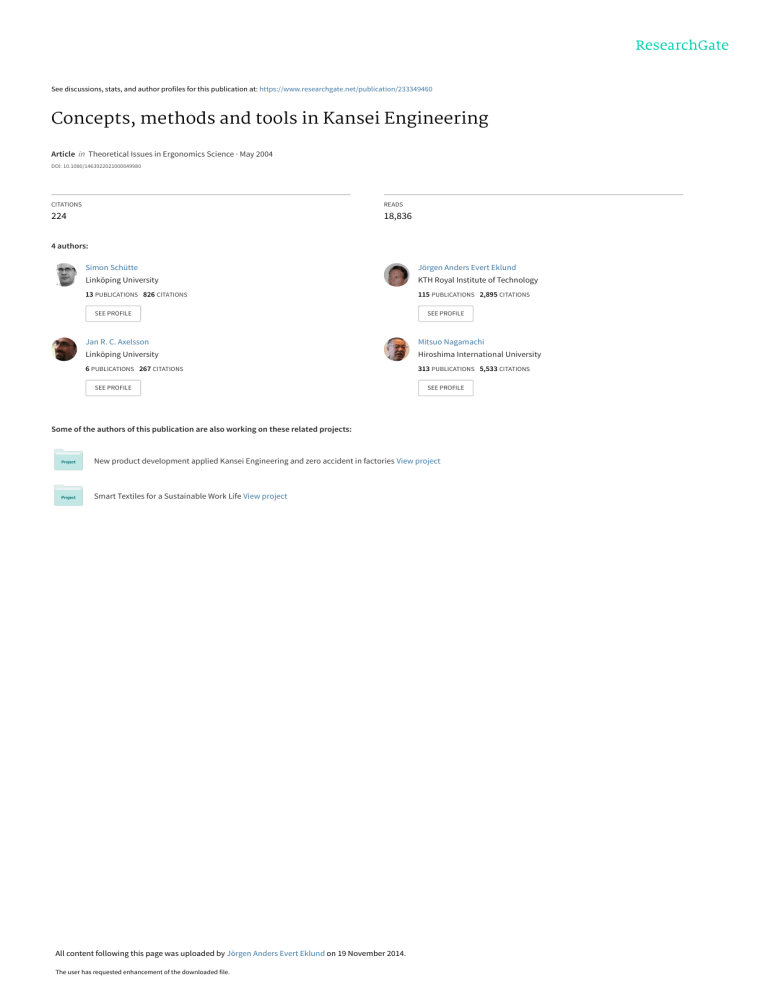
See discussions, stats, and author profiles for this publication at: https://www.researchgate.net/publication/233349460 Concepts, methods and tools in Kansei Engineering Article in Theoretical Issues in Ergonomics Science · May 2004 DOI: 10.1080/1463922021000049980 CITATIONS READS 224 18,836 4 authors: Simon Schütte Jörgen Anders Evert Eklund Linköping University KTH Royal Institute of Technology 13 PUBLICATIONS 826 CITATIONS 115 PUBLICATIONS 2,895 CITATIONS SEE PROFILE SEE PROFILE Jan R. C. Axelsson Mitsuo Nagamachi Linköping University Hiroshima International University 6 PUBLICATIONS 267 CITATIONS 313 PUBLICATIONS 5,533 CITATIONS SEE PROFILE SEE PROFILE Some of the authors of this publication are also working on these related projects: New product development applied Kansei Engineering and zero accident in factories View project Smart Textiles for a Sustainable Work Life View project All content following this page was uploaded by Jörgen Anders Evert Eklund on 19 November 2014. The user has requested enhancement of the downloaded file. Concepts, Methods and Tools in Kansei Engineering Simon T. W. Schütte1, Jörgen Eklund1, Jan R.C. Axelsson1 and Mitsuo Nagamachi2 1 Quality and Human-Systems Engineering, Department of Mechanical Engineering, Linköping University, SE-58183 Linköping, Sweden 2 Collage of Human and Social Environment, Hiroshima International University, 555-36 Gakuendai, Kurosecho, Hiroshima 724-0695, Japan Contact: Simon Schütte, Linköpings Universitet, IKP/Q, SE-58183 Linköping, Sweden Tel: +46-13-28 1782, Mobil: +46-73-64 18 278, Fax: +46-13-28 2742 E-mail: simsc@ikp.liu.se Abstract Trends in product development today indicate that many products will become hard to distinguish by the customer due to functional equivalency. Customers will therefore base their decisions on more subjective factors. Moreover, products will in future consist to a higher grade, of a combination of a tangible and intangible part. Kansei Engineering is a tool translating customer’s feelings into concrete product parameters and provides support in future product design. The aim of this paper is to propose a framework in Kansei Engineering facilitating the understanding of the different types of Kansei Engineering and opening Kansei Engineering for the integration of new tools. The new structure includes the choice of a product domain, which can be described from a physical and a semantic perspective building a kind of vector space each. For the latter mentioned space the Semantic Differential Method is used. In the following step the two spaces are merged and a prediction model is built, connecting the semantic space and the space of product properties together. The resulting prediction model has to be validated using different types of post-hoc tests. Keywords: Kansei Engineering, proposed framework, Semantic Differential Method, Product Development 1 Introduction Kansei Engineering is a proactive product development methodology, which translates customers’ impressions, feelings and demands on existing products or concepts into design solutions and concrete design parameters. As portrayed in Figure 1 the intended psychological impression about a future product is input to a Kansei Engineering System (KES) which in turn delivers the required product design parameters evoking the aimed impression. [insert figure 1 about here] Figure 1: Kansei Engineering System (KES), adapted from Nagamachi (1997). Kansei Engineering is mainly a catalyst for a systematical development of new and innovative solutions, but can also be used as an improvement tool for existing products and concepts. Kansei Engineering is based on subjective estimations of product and concept properties and gives expression to the demands on the products which customers are not aware of by using semantic tools developed by Osgood (1969). Several success stories contribute to the sound record Kansei Engineering has nowadays in Japanese companies. Mazda used Kansei Engineering in the development of it’s model Miyata (in Europe: MX 5). More then ten years after its first launch the Miyata is the best sold sports coupé in the world (The Guinness Book of Records, 2001). When Sharp introduced a new developed video camcorder having a LCD-display in stead of a conventional ocular, they increased the market share in this segment from 3% to 24%. Even in this case Kansei Engineering identified the customer’s demands on the new product leading to the new concept. A third example showing the wide product range Kansei Engineering is dealing with is Wacaol. This underwear producing company collected Kansei data about the usage of a common brassiere and based on this information designed a new model. Their market share topped at 42% on Japanese markets (Nagamachi, et al. 2001). The method was developed by Prof. Misuto Nagamachi in the early 70’s in Japan and has been used in many Japanese companies. In the middle of the 90’s the method spread to the United States and Europe. Over the 30 years of its existence Kansei Engineering has developed substantially. From the early beginnings Kansei Engineering used tools based on expert knowledge, resembling Quality Function Deployment (QFD), but soon Nagamachi and his colleagues added mathematical models in an attempt to substitute expert knowledge. Later on several different techniques were applied so that a total number of six different Kansei Engineering procedures have now been tested and available. Table 1 presents the currently available types of Kansei Engineering in order of their introduction. Table 1 Types of Kansei Engineering (Nagamachi 2001). [insert table 1 about here] The basic ideas behind Kansei Engineering have been published in Japanese by Prof. Nagamachi and his colleagues. Most of the available English literature presupposes a certain basic knowledge about Kansei Engineering. The aims of this paper are to give an overview of different existing approaches in Kansei Engineering, and to introduce a conceptual model of the Kansei Engineering process, in order to demonstrate the particular use of the different tools and to facilitate the use of the Kansei Engineering concept. In the following, essential definitions of expressions and terms in Kansei Engineering are given and a conceptual model is introduced, followed by a discussion and conclusions. 2 Expressions and terms in Kansei Engineering context 2.1 Kansei Kansei is a Japanese word. When translated into English it might mean ‘consumer’s psychological feeling and image’ (Nagamachi 1997). This means that the Kansei is the impression somebody gets from a certain artefact, environment or situation using all the senses of sight, hearing, feeling, smell, taste as well as her cognition. Subsequent a complex mind pattern is built and stored in the human brain containing all the experienced impressions, building the foundation of human behaviour. Selma Lagerlöv describes the main actor’s Kansei in her famous book ‘Nils Holgersson’ after he began his journey through Sweden on the back of a tame goose: ‘Nils had grown so giddy that it was a long time before he came to himself. The winds howled and beat against him, and the rustle of feathers and swaying of wings sounded like a great storm. Thirteen geese flew around him, flapping their wings and honking. They danced before his eyes and they buzzed in his ears. He didn’t know whether they were flying high or low or in what direction the were travelling’ (Lagerlöv 1984). Although of every reader of the book gets their own highly individual Kansei of this situation depending on their own experiences and mood, there are common patterns visible. Probably everybody agree, that Nils got into a very unpleasant situation and is in full panic. However even these common patterns can change by changing the cognition. The situation described may not appear as violent to today’s reader as it affected contemporary readers. Therefore when one measure people’s Kansei, one should be aware of the fact that the values measured are perishable and should be used as quickly as possible. 2.2 Product Since Kansei Engineering deals mainly with product development the perspective of Kansei Engineering on products has to be clarified. The word ‘product’ originates from the Latin word productum, which means result, or gain. During the industrial revolution it became synonymous with industrially manufactured artefacts. Nowadays the expression also includes even services (Röstlinger and Goldkuhl 1999). Originally Kansei Engineering only focused on artefacts, but recently several studies were conducted on internetservices proving that Kansei Engineering has a much wider applicability (Nishino, et al. 1999). According to Röstlinger and Goldkuhl artefacts can be connected with certain services e.g. delivery and installation of a washing machine (Röstlinger and Goldkuhl 1999). Since the number of this type of products will increase in the future (IVA 1999), Kansei Engineering has to be enabled to conduct examinations of both service and artificial part of the products in only one study. Figure 2 portrays the 3 different types of products Kansei Engineering can evaluate. [insert figure 2 about here] Figure 2: Product Definition used by Kansei Engineering. 2.3 Product Properties Every product possesses a number of properties, which enables it to fulfill the function the product is originally designed for. These properties can be: design parameters, this means deliberately integrated functions, or product traits, e.g. constraints when designing a product. A product parameter is an intentionally designed property of the product. In contrast, a product trait is considered to be a product property, which was not intended by the designer but nevertheless a property of the product. An example: When designing a cell phone, the housing is usually made out of plastic, since it is easy and cheap to produce, light, shock-absorbing and it has a smooth surface. These are the intended design parameters. On the other hand the material has a number of unintended traits, like the shock absorption, its thermal conduction etc., which are not originally intended but are now properties of the phone. All the properties have a potential impact on the user of the product. Unfortunately not all product properties can be treated by methods evaluating customer needs, but a certain selection has to be made. To make this explicit the selected properties for evaluation with Kansei Engineering Methodology are called items (Nishino 2001). An item, in turn, can include several categories, completing the information about the item. The item ‘colour’ can i.e. be completed by the categories ‘green’, ‘blue’, etc.. 3 Semantic Differential Method Charles E. Osgood developed a method of measuring the emotional content of a word more objectively, called ‘semantic differential technique’, which more than 30 years later became one of the foundations of Kansei Engineering. He was influenced by the different political ideologies, which became evident in World War II and the following Cold War. His assumption was to make a separatation between the object and an object-representing sign: • The object, ‘which is a pattern of stimulation which evokes reactions on the part of an organism’, and • The sign, ‘which is any pattern of stimulation which is not the object but yet evokes reactions relevant to ‘object’-conditions under which this holds lying the problem for theory’ (Osgood 1952) This can be show using a hammer as an example. The spoken word ‘hammer’ is e.g. not the same stimulus as the object hammer. The former is a pattern of sound waves and the latter a combination of visual, olfactory and tactual sensations. The word hammer elicits a type of behaviour, which is in some manner relevant to the object hammer. This means that the spoken or read word ‘hammer’ is the sign for the object ‘hammer’. Osgood’s research resulted, in the simplest terms, into the question ‘Under what conditions does something which is not an object become a sign of that object?’(Osgood 1952). To answer this question, Stagner and Osgood (1946) conducted questionnaire studies. The subjects chosen were supposed to rate signs (words) of objects like Pacifist, Russians, Germans, Dictator or Neutrality (remember that the experiments were conducted under World War II) on bipolar scales. These scales were defined with a number of contrasting adjectives at each end on which the participants checked that position which best represent the direction and intensity according to their point of view. An example of the scale type used is shown in Figure 3. [insert figure 3 about here] Figure 3: Example of a 7-point rating scale, originally used by Osgood (1952). The analysis which applies multivariate analysis tools, led to the discovery of the existence of a common pattern (Carroll 1959). It could be seen that all the word pairs examined span a three dimensional orthogonal vector space as it is presented in Figure 4. Osgood called this space the semantic space and the method semantic differential techniques. [insert figure 4 about here] Figure 4: The Semantic space adapted from Carroll (1959). When the word pairs in the individual factors were considered, it was possible to identify a pattern and name these factors. • Evaluation (E) usually contains word pairs like: good-bad, timely-untimely, kind-cruel, beautiful-ugly, successful-unsuccessful, importantunimportant, true-false, wise-foolish, etc. All these word-pairs have in common a possibility to evolve into a better or worse stage. • Potency (P) usually contains word-pairs like: large-small, hard-soft, masculine-feminine, strong-weak, etc. These pairs characterise a potential, a capacity for change. • Activity (A) is characterised by word pairs like: active-passive, fast-slow, hot-cold, sharp-dull, angular-rounded, etc. This factor indicates the grade and speed of change. Applying these factors into the semantic space, as is seen in Figure 4 these factor names become the names of the axes. Now it is possible to project every concept in the semantic space and give it an individual position. For example a dictator scores high on the potency axis (hard, strong, etc.), low on the evaluation axis (bad, cruel, ugly, etc.) and receives low positive values on the activity axis (active, fast…) 4 Proposing a framework for Kansei Engineering Figure 5 portrays a framework for Kansei Engineering Methodology based on the literature review above. The basic idea is to describe– based on an earlier chosen domain- the idea behind the product from two different perspectives: 1. The semantic description 2. The description of product properties These two descriptions span a kind of vector space each. Subsequently these spaces are merged in the synthesis phase with each other indicating which of the product properties evokes which semantic impact. First after these steps have been carried out it is possible to conduct a validity test, including several types of Post-Hoc analyses. As a result from this step the two vector spaces are updated and the synthesis step is run again. When the results from this iteration process are adequate, a model can be built describing how the semantic and the space of application are associated. [insert figure 5 about here] Figure 5: A model of the Kansei Engineering concept. 4.1 Choosing the Product Domain Selecting the domain includes the selection of a target group and market-niche and specification of the new product. Based on this information, product samples are collected, representing the domain. The Kansei Domain can be understood as the ideal concept behind a certain product. Despite the fact that a circle can never be drawn perfectly round, everybody knows what the perfrect idea of a circle is. The Kansei domain is dealt with in the same way. It is an abstract superordinated mind structure while the representative products are either tangibles or intangible samples from this domain. As a result, a domain includes both existing products, concepts and even still unknown design solutions. The task in this first step is to define the domain and find representatives (products, drawings, samples, etc) covering an as big as possible part of the domain. 4.2 Spanning the Semantic Space 4.2.1 Measuring the Kansei Since the Kansei is an internal sensation the question arising is how the Kansei can be grasped and measured. Unfortunately all the presently available measuring methods are external methods interpreting different body expressions. A series of measurement methods have been developed, interpreting: • Physiological responses (e. g. heart rate, EMG, EEG), • People’s behaviors and actions, • Factual and body expressions, • Words (spoken). (Nagamachi 2001) The list above is sorted according to the complexity of behavioural patterns. Since the Kansei is a very multifaceted phenomena, Kansei Engineering mainly uses the evaluation of words and their emotional impact on human mind. This guarantees detailed descriptions of the Kansei but as a result those parts of the Kansei, which cannot explicitly be expressed in words, are latent or in worst case excluded. Moreover there is a risk that words which not belong to the domain are collected as well. These impurities cannot be detected until a post-hoc test is conducted, coursing a certain amount of extra work. Figure 6 depicts that. [insert figure 6 about here] Figure 6: The excerpt from the Kansei measured by Kansei Engineering. Kansei Engineering is based on subjective estimations of products and concept properties and helps users to express their demands on the products-even those, which they are not aware of. Therefore semantic tools e.g. Semantic Differential Method developed by Osgood, Suci et al. (1969) are used. In this way it is possible to quantify such complex emotions such as spatial perception or the impression of the sound of vehicles (Rydman and Sandin 2000). 4.2.2 The Procedure of Spanning the Semantic Space In practice the step ‘Span the semantic space’ in Figure 5 is carried out in three steps as portrayed in Figure 7 below. Using the desired domain as a starting point, Kansei Words, describing the considered product are collected. In a second step the number of words is reduced to a more practical number. This can be done, by using different tools as described below. In the last part the data is compiled in a standardized way in order to facilitate the following synthesis phase. If important Kansei Words are missed in this step, the result can become practically unusable. Hence it is better to select a few more words than necessary. [insert figure 7 about here] Figure 7: Spanning the Semantic Space broken down into three steps (insprired by Nagamachi (1997) and Osgood and Suci (1969)). 4.2.3 Collection of Kansei Words A Kansei word is a word describing the product domain. Often these words are adjectives but other grammatical forms are possible. E.g. when describing the domain ‘fork-lift truck’, adjectives like effective, robust, quick, etc. but also verbs and nouns (acceleration) can occur (Schütte and Eklund 2001). In order to get a complete selection of words all available sources have to be used, even if the emerging words seem to be similar or the same. Suitable sources can be: • Magazines • Pertinent Literature • Manuals • Experts • Experienced Users • Relating Kansei Studies • Ideas, visions An important point is to translate ideas and visions into Kansei words because also non-existing solutions should be considered. Only in this way can Kansei Engineering be used as a creative product development tool, which generates new and revolutionary solutions. The task is to describe the domain, not the existing products. Depending on the domain considered, the number of existing Kansei word generally varies between 50 and 600 words (Nagamachi 1997). Since it is of great importance to collect all existing words, the word collection is continued until no new words occur. The gathered data will critically influence the validity of the results if important words are missing. 4.2.4 Selection of Kansei Words using Data Reduction Methods Generally it is considered advantageous to use the original number of words, because a selection would mean a loss of information. On the other hand if the number of words collected exceeds a critical size it can be difficult to find volunteers to fill in questionnaire forms, due to the amount of time needed. That means in therefore that the statistical power may suffer from a low number of participants (Körner and Wahlgren.L. 2000). Besides that the quality of the gathered data will also be relatively poor due to effects of fatigue on the participants (SCB 2001). Hence, the data quality is appreciably affected by the number of Kansei words or the evaluation time of the questionnaire reaches critical dimensions, and so a reasonable data reduction must be carried out. Two empirically tested possibilities are portrayed in Figure 8 [Arnold, 2001 #140]. [Insert figure 8 about here] Figure 8: Selection of Kansei Words using Data Reduction Methods. One of the possible word reduction methods presented in Figure 8 is a pilot study using Osgood’s Semantic Differentials and factor analysis. The participants are supposed to think about the domain per se and answer the question ‘How do you think this Kansei Word correspond to the Domain?’ Subsequent factor and/or cluster analysis is applied in order to reveal the connections between the words and to allow the choice of representatives for each factor or cluster which become the new set of Kansei words. Another possibility is to use a focus group and/or expert group to group the words according to their affinity and choose representatives for every group (Card-System). Since the outcome of this will be a very condensed number of words, the validity of these words must be proved. That can be done in two steps: • Manual inspection if the selected words represent the semantic space sufficiently directly after the clustering. • Executing a post-hoc factor analysis after finished the main study. The resulting factors should at least span a 3 dimensional vector room (the Semantic Space) (Weinreich 1958). What method is used depends on the context, but no study has yet compared the two different methods with each other. 4.2.5 Compiling Data After the relevant words have been collected and rated on the semantic scales the number of words selected are reduced in a way that the remaining words represent the semantic space properly. The outcome from this step is a list containing the rankings of the selected words against the artefacts used for each participant. This can be stacked in a three dimensional matrix as it is presented in Figure 9. [insert figure 9 about here] Figure 9: Raw store data matrix, obtained when a group of subjects (x-axis) judges a sample of concepts (y-axis) against a set of semantic scales (z-axis). Each cell contains a number from 1 to 7, representing the judgement of a particular concept on a particular scale by a single subject. (adapted from Osgood and Suci (1969)). 4.3 Spanning the Space of Product Properties The spanning of the space of product properties is similar to the semantic space. One underlying idea is that there is an existing vector space depicting the domain’s properties. The task in this part is to collect all the attributes representing the chosen domain and select those, which apparently have the biggest impact on the user’s Kansei and choose products representing the chosen product properties before the data is compiled for the following synthesis phase. The step shown in Figure 5 is presented more in detail in Figure 10. [insert figure 10 about here] Figure 10: Spanning the space of product properties, broken down into 3 steps steps (insprired by Nagamachi (1997) and Osgood and Suci (1969)). The possible tools are multifaceted and can both integrate several or only one step of the proposed concept. Table 2 portrays the currently available tools. In most studies these tools are not solely used, but they can be combined with each other. Table 2:Possible tools for spanning the space of product properties. [Insert table 2 about here] The spanning of the space of product properties has some sensitive points, where limitations are made. In order to make this discussion visible it has to be documented carefully. One of these points is the selection process. Depending on which technique is used the result may vary. Subjective estimations especially in the first case can play an important role. When using an affinity diagram or a pareto diagram a right choice of the evaluation group members is essentially important. As mentioned in the choice of the domain, the group members should ideally be randomly chosen from the intended target group in the domain. 4.3.1 Manual collection and selection made by the designer The most common variant in every designing process is the manual collection and selection of the product attributes made by the product designer alone. In complex matters technical aids can be used, like fish-bone diagrams, etc. However, in the end it is the designer’s experience and intuition, which decide which product parameters will be taken into account. The quality of the result depends on factors like the designer’s experience, the company structure or the product’s maturity. 4.3.2 Using quality tools in product development When working in the early stages of a project, the product specifications usually are not fixed. So designers work more holistically and in teams. All opinions could contain a potential benefit and everybody’s knowledge should be included in the future product. Quality techniques can provide a variety of different tools, which can be used to achieve this. In this case an affinity diagram (Klefsjö, et al. 1999) can be applied, including a brainstorming phase when collecting the existing parameters and a joint decision phase containing a ranking and selection of the different solutions. 4.3.3 Collection and selection made by using focus group data In the third alternative the collection and selection processes are separated and supported by two different tools. In the first step all the existing product parameters are collected from different sources like: • Technical documents • Comparisons of competing products • Magazines • Pertinent Literature • Manuals • Experts • Experienced Users • Related Kansei Studies If one feel satisfied with only these sources, it would not be possible to develop innovative products. Hence it is necessary to think abductively. It is more important to look for things, which are not present and to search the domain properties; this means all imaginable properties the domain could have. Therefore more sources have to be viewed: • Ideas • Visions • Concept studies • Analysis of the usage of existing products and conclusions drawn • Related product groups In the second step a focus group, consisting of potential users, is asked to choose desired product properties from a list containing the collected domain properties1. A frequency analysis or pareto diagram over the product traits mentioned reveals the importance and rank. Figure 11 shows the pareto diagram made for wrist watches. It can be seen that the type of dial, the material and the color represent together more than 80% of all votes. [insert figure 11 about here] Figure 11 Pareto diagram, importance of product properties of watches. The following products have to possess these parameters. These products will be used in the synthesis in order to represent the new product’s items (the selected properties of the new product; see also Section 2.3). In many cases it is not possible to find products responding to any item; especially when the item originates from a concept or idea. In these cases it is possible to use computer-made images or video-clips. The products have to be chosen carefully according to the rules of design of experiments, otherwise an any following statistical treatment can cause problems. 4.3.4 Compiling As mentioned before distributing the data in a standardized way facilitates the choice of the evaluation tool in the synthesis phase. Moreover multiple tools can be used on the same data in order to compare and validate the results since, the input data required is the same and does not have to be conditioned before using a different tool. 4.4 Synthesis In the synthesis step the Semantic Space and the Space of Properties are linked together as displayed in Figure 12. For every Kansei Word a number of product properties are found, affecting the Kansei Word. Ishihara conducted a study on beer can design (Ishihara, et al. 1998). His results showed e.g. that the score of the Kansei Word ‘bitter’ is most affected by the can colour and the 1 Domain properties are all the properties the considered product could have. shape of the logo. In fact a black color in combination with a non-oval logo evoked a strong bitter Kansei, whereas a white can with an oval logo involved the opposite Kansei. [insert figure 12 about here] Figure 12: The Synthesis phase KW= Kansei Word. The research on establishing these links has been one of the core parts of Nagamachi’s work with Kansei Engineering in the last years. At present a number of different qualitative and quantitative tools are available. Since the incoming data are stacked in a standardized way every tool can be used, and it is even possible to use different tools and compare the result afterwards in order to reveal the best suitable tool. 4.4.1 Qualitative treatments People working with design are usually aware of the links between peoples’ impressions and the product traits. They know the target groups well from different sources and have a ‘sixth sense’ or intuition for how the products should be designed. This latent knowledge can not be expressed and is very difficult to communicate. By providing data from the previous steps the experts become able to interconnect their knowledge with their colleagues and in that way create a new consciousness. QFD uses almost the same principles when linking the customers needs to the metrics in the house of quality (Nagamachi, et al. 2001). In Kansei Engineering context this procedure is called Kansei Engineering Type I. 4.4.2 Statistical Treatments In many cases experts are more aware of the user’s demands than the users themselves. On the other hand users can easily assess whether a product is suitable in a certain respect or not. Nagamachi has developed a number of different statistical procedures using different mathematical implements to capture the user’s impression and make the synthesis independent of expert knowledge (Nagamachi 2001). • Linear regression (Ishihara 2001) • General Linear Model (GLM) (Arnold and Burkhard 2001) • QT1 (Komazawa and Hayashi 1976) • Neural Networks (Ishihara, et al. 1996) • Genetic Algorithm (Nishino, et al. 1999) • Rough set analysis (Nishino, et al. 2001) The use of different tools depends on the context. Emotions and feelings do not follow mathematical laws. Sometimes it is possible to use linear methods, which are easiest to handle, sometimes more complex models have to be applied. The outcome of all the tools presented describes only in which way the Kansei words are correlated to the product properties. 4.4.3 Test of Validity and Iterations At this point of the Kansei procedure a model of the Kansei is available but nothing is said about the validity of this model. Using Weinreich's (1958) ideas about the Semantic Space it is possible to conduct a factor analysis from the gathered data and compare the results with the Kansei words delivered from the Semantic Space. As mentioned in Section 4.2.1 the number of output words was to big deliberately. By comparing the result from the first (after the selecting the Kansei Words) and the second factor analysis (after completed synthesis) it is now possible to spot the words which have no effect on the Kansei. This is fed back to the Semantic Space and if an iteration process is necessary only the new words are used. Theoretically this procedure can also be used for determining which of the product properties is obsolete, but this has not been tested yet. Newly developed models can be tested with other different products, possessing certain product items. By comparing the predicted value with the acquired data from a new test questionnaire the model quality can be determined. 4.4.4 Model Building When the validity tests give a sufficient result, the data gathered from the synthesis can be presented as a model. These models are a function depending on the product properties and predict the Kansei score for a certain word: y Kansei = f product properties Depending on the chosen tool the function can be qualitative, linear or non-linear. 5 Discussion The authors developed the key Figure (Figure 5) based on an in-depth analysis of the available literature, and experience gathered from different studies conducted at Linköping University. Contemplating Kansei Engineering from this perspective reveals the ideas on which Kansei Engineering is based, giving the opportunity for a better understanding of the existing types of Kansei Engineering and gives scope for future expansion. The clear distinction between the Kansei Engineering concept and the possible tools for the different steps, allows the identification of both the well-developed areas but also enabled the authors to identify further development opportunities, and to propose future research areas and new tools. Beginning from the top of Figure 5 it can be remarked that little work has been reported on the ‘choice of domain’. Usually the domain and the target groups are pre-chosen, based on the product manufacturer’s experience. Proceeding downward in Figure 5 the domain is split into the Semantic Space and the Space of Product Properties. Whereas the Semantic Space is supported by Osgood’s work, only a few tools are available for the Space of Product Properties. The authors present a number of possible tools, e.g. from the field of quality, but more research on this field is required. A lot of attention is paid to the synthesis step, since the synthesis step is one of the core parts in Kansei Engineering and Nagamachi and colleagues are working constantly to develop and adapt new tools in this area. Subsequently the ‘test of validity’ is carried out. Although a number of advanced mathematical tools is being developed, giving feedback to the Semantic Space and confirming the validity of the delivered Kansei Words, no tool is available to do the same with the Space of Product Properties. Would is be possible to determine the validity of the choice of product properties in a similar way? It is the goal of Kansei Engineering to provide a model of the relationship between the product properties and the Kansei. A model is built in almost all studies, but it is still difficult to say within which limits this model is valid. Such limits can be the duration of validity of the chosen Kansei Words, the target groups, product groups, etc. 6 Conclusions The Kansei Engineering concept in this paper introduced is a synopsis of the methods and tools used in Kansei Engineering in order to evaluate the relationship between the individual’s psychological experience of a certain product and its design. Seen from this perspective, this paper can be understood in a wider sense as a definition of contemporary Kansei Engineering, allowing the opportunity for further development. The key-Figure (Figure 5) identifies the different areas in Kansei Engineering and links the available tools from the different areas to different steps. The adaptation of the different tools to Kansei Engineering can in some cases be difficult, since many tools used in Kansei Engineering are borrowed from other scientific or technological fields. This results in restricted validity of the tools used and has to be taken in account when drawing conclusions from a Kansei Engineering study. Some of these tools require great resources and consume a great amount of time, affecting the duration of the validity and invoking high costs for the user. So it is desirable to strive after less time consuming methods or to complement Kansei Engineering with a type evaluating more quantitative data. 7 Acknowledgements The Swedish authors wish to thank Prof. Nagamachi, and Prof.s Ishihara and Nishino from Hiroshima International University for their help and support on many occasions. Moreover we want to express our thanks to BT Industries for financial support and providing us with the opportunity to test our theories in practice. 8 References ARNOLD, K. and BURKHARD, D. 2001, Kansei Engineering- From the Customers Point of View, Special Report LiTH-IKP-R-1226, IKP, Linköping. CARROLL, J. B. 1959, Review of The Measurement of Meaning, in Snider, J. G. and Osgood, C. E. (ed.), Semantic Differential Technique (Chicago: Aldine Publishing), 96-115. FRÅGA RÄTT, SCB 2001, 2001, Special Report Statistiska Centralbyrå, The Guinness book of records, 2001, Guiness. ISHIHARA, S., ISHIHARA, K., NAGAMACHI, M. and MATSUBARA, Y. 1996, Neural network approach for Kansei analysis on milk carton design, Proceedings of Human Factors in Organizational Design and Management - V, (Breckenridge, USA: Elsevier Science B.V.), 7-12. ISHIHARA, S., ISHIHARA, K. and NAGAMACHI, M. 1998, Hierarchical Kansei analysis of beer can using neural network, Proceedings of Human Factors in Organizational Design and Management - VI, (Amsterdam: Elsevier), 421-425. ISHIHARA, S. 2001, Kansei Engineering Procedure and Statistical Analysis, Workshop at International Conference on Affective Human Factors Design, (Singapore). IVA 1999, Styrkor, svagheter, möjligheter och hot, Special Report 91-7082-657-9, KLEFSJÖ, B., ELIASSON, H., KENNERFALK, L., LUNDBÄCK, A. and SANDSTRÖM, M. 1999, De sju ledningsverktygen, (Lund:Studentlitteratur). KOMAZAWA, T. AND HAYASHI, C. 1976, A Statistical Method for Quantification of Categorical Data an its Applications to Medical Science, in de Dombal, F. T. and Gremy, F. (ed.), North-Holland Publishing Company), KÖRNER, S. and WAHLGREN.L. 2000, Statistisk Dataanalys, in (ed.), (Lund: Studentlitteratur), 195-196. LAGERLÖV, S. 1984, The wonderful adventures of Nils, (London:J.M. Dent & Sons). NAGAMACHI, M. 1997, Kansei Engineering: The Framework and Methods, in Nagamachi, M. (ed.), Kansei Engineering 1 (Kure: Kaibundo Publishing co.,LTD), 1-9. NAGAMACHI, M. 2001, Workshop 2 on Kansei Engineering, Proceedings of International Conference on Affective Human Factors Design, (Singapore, 2001: NAGAMACHI, M., ISHIHARA, S. and NISHINO, T. 2001 Personal communication NISHINO, T., NAGAMACHI, M., ISHIHARA, K., ISHIHARA, S., ICHITSUBO, M. and KOMATSU, K. 1999, Internet Kansei Engineering System with Basic Kansei Database and Genetic Algorithm, Proceedings of TQM and Human Factors, (Linköping, Sweden: Center for Studies of Humans, Technology and Organization), 367-372. NISHINO, T. 2001, Exercises on Kansei Engineering, (Hiroshima International University). NISHINO, T., NAGAMACHI, M. and ISHIHARA, S. 2001, Rough Set Analysis on Kansei Evaluation of Color, Proceedings of The International Conference on Affective Human Factors Design, (Singapore: Asean Academic Press), OSGOOD, C. E. 1952, The Nature and Measurement of Meaning, in Snider, J. G. and Osgood, C. E. (ed.), Semantic Differential Technique (Chicago: Aldine Publishing Company), 3-41. OSGOOD, C. E. 1969, The Nature and Measurement of Meaning, in Osgood, C. E. and Snider, J. G. (ed.), Semantic differential technique - a sourcebook (Chicago: Aldine publishing company), 3- 41. OSGOOD, C. E. and SUCI, G. J. 1969, Factor Analysis of Meaning, in Osgood, C. E. and Snider, J. G. (ed.), Semantic differential technique - a sourcebook (Chicago: Aldine publishing company), 42- 55. OSGOOD, C. E., SUCI, G. J. and Tannenbaum, P. H. 1969, Measurement of Meaning, in Osgood, C. E. and Snider, J. G. (ed.), Semantic differential technique - a sourcebook (Chicago: Aldine publishing company), 56-82. RYDMAN, K. and SANDIN, J. 2000, Kansei Engineering-methodbeskrivning och tillämpning på tryckkänsla hos tangenter, Linköping/Sweden, LiTH-IKP-Ex 1784. RÖSTLINGER, A. and GOLDKUHL, G. 1999, Produktbegreppet- En praktikteoretisk innebördesbestämmning, Special Report 1999:07, Centre for Studies of Humans, Technology and Organsiation, Linköping. SCHÜTTE, S. and EKLUND, J. 2001, An Approach to Kansei Engineering- Methods and Case Study on Design Identity, Proceedings of Conference on Human Affective Design, (Singapore: Asean Academic Press, London), STAGNER, R. and OSGOOD, C. E. 1946, Impact of war on a nationalistic frame of reference, in (ed.), J. soc. Psychol 389-401. WEINREICH, U. 1958, Travels through Semantic Space, in Snider, J. G. and Osgood, C. E. (ed.), Semantic Differential Technique (Chicago: Aldine Publishing Company), 116-129. View publication stats
